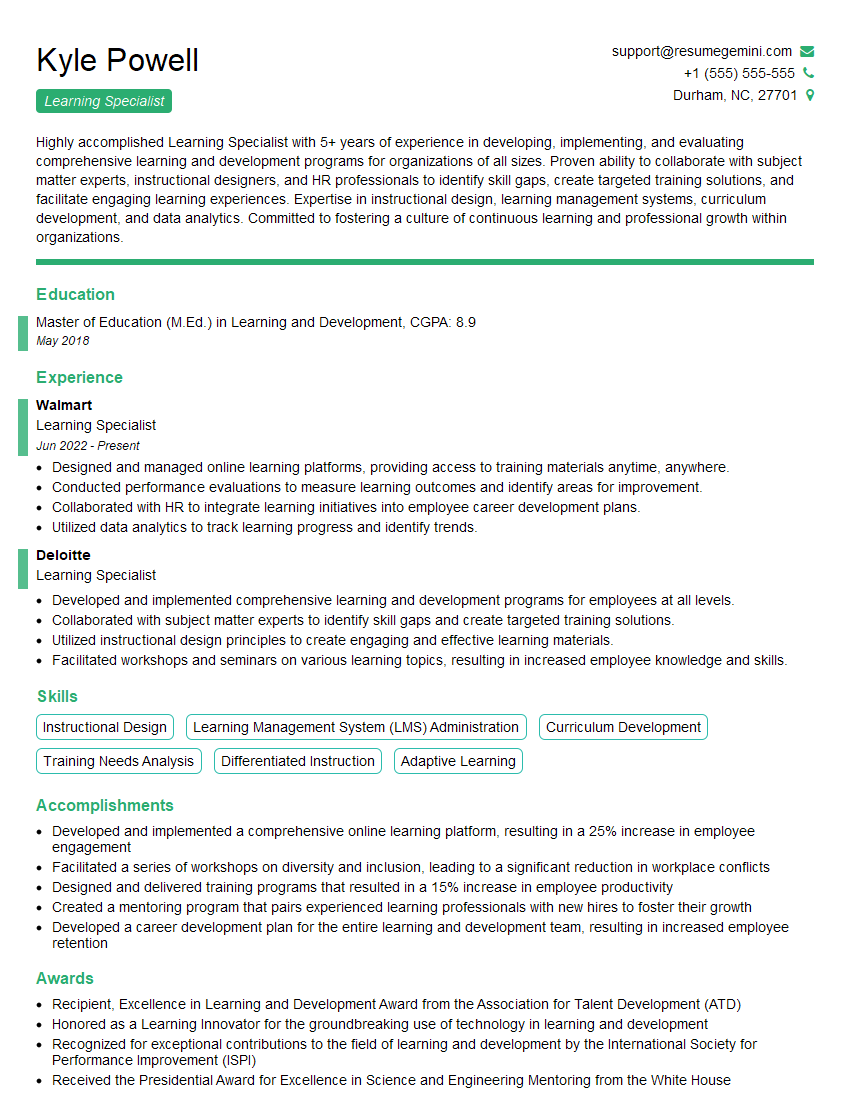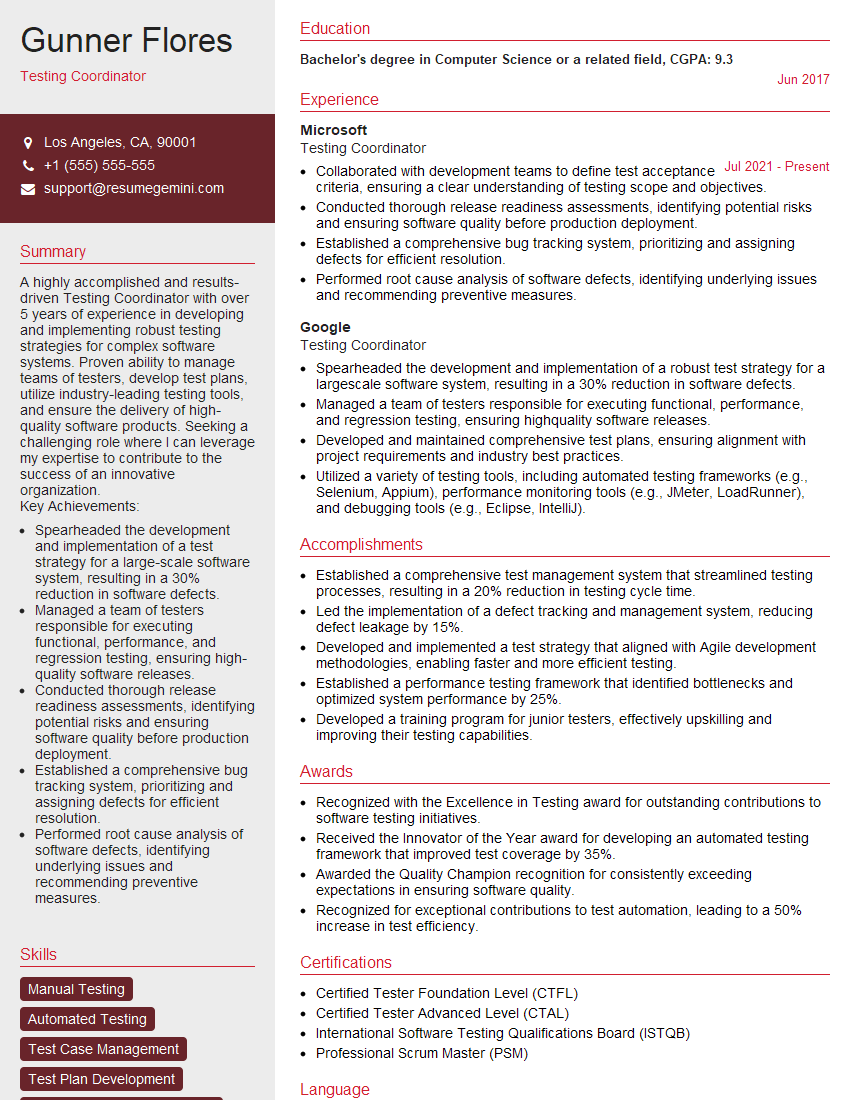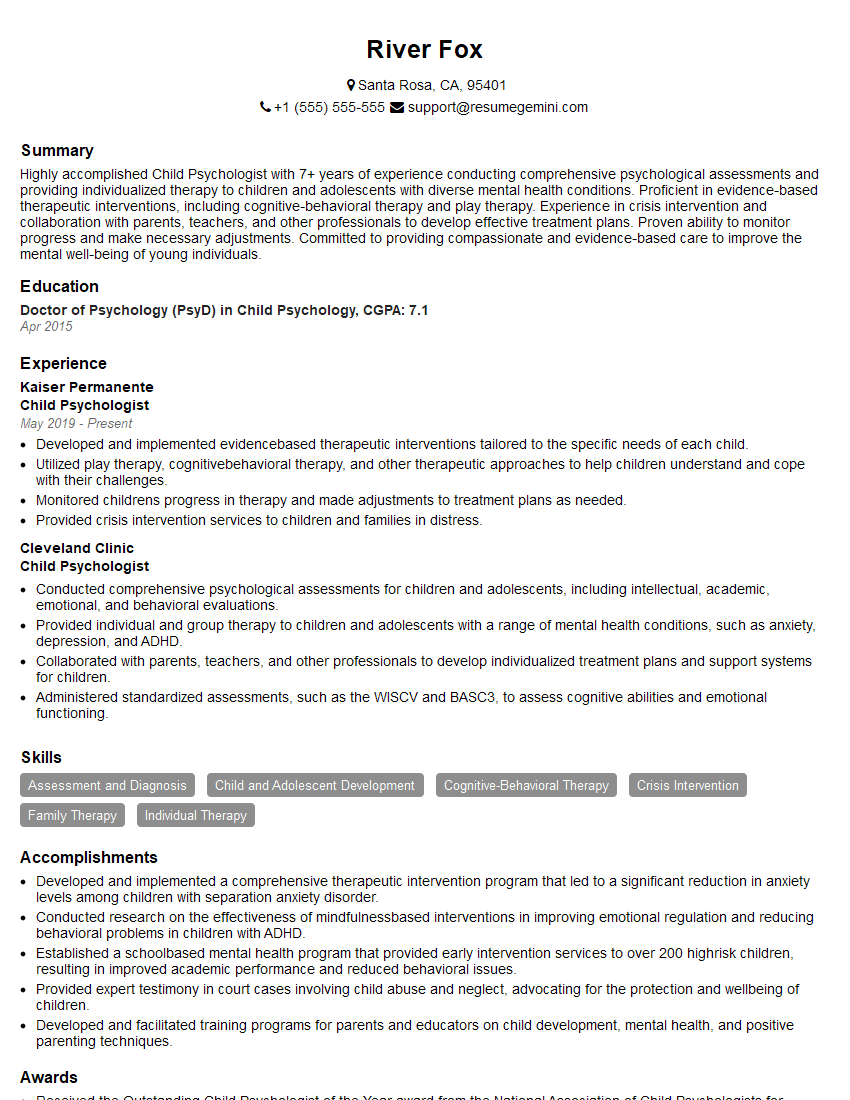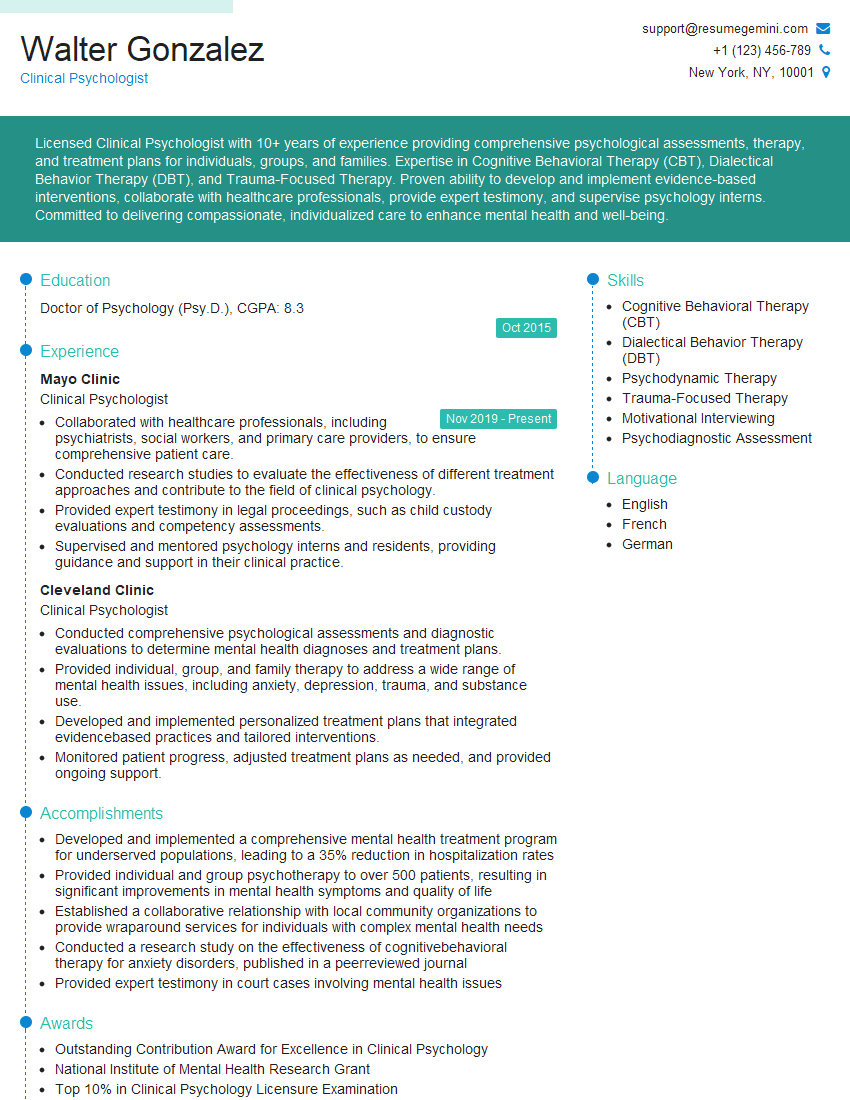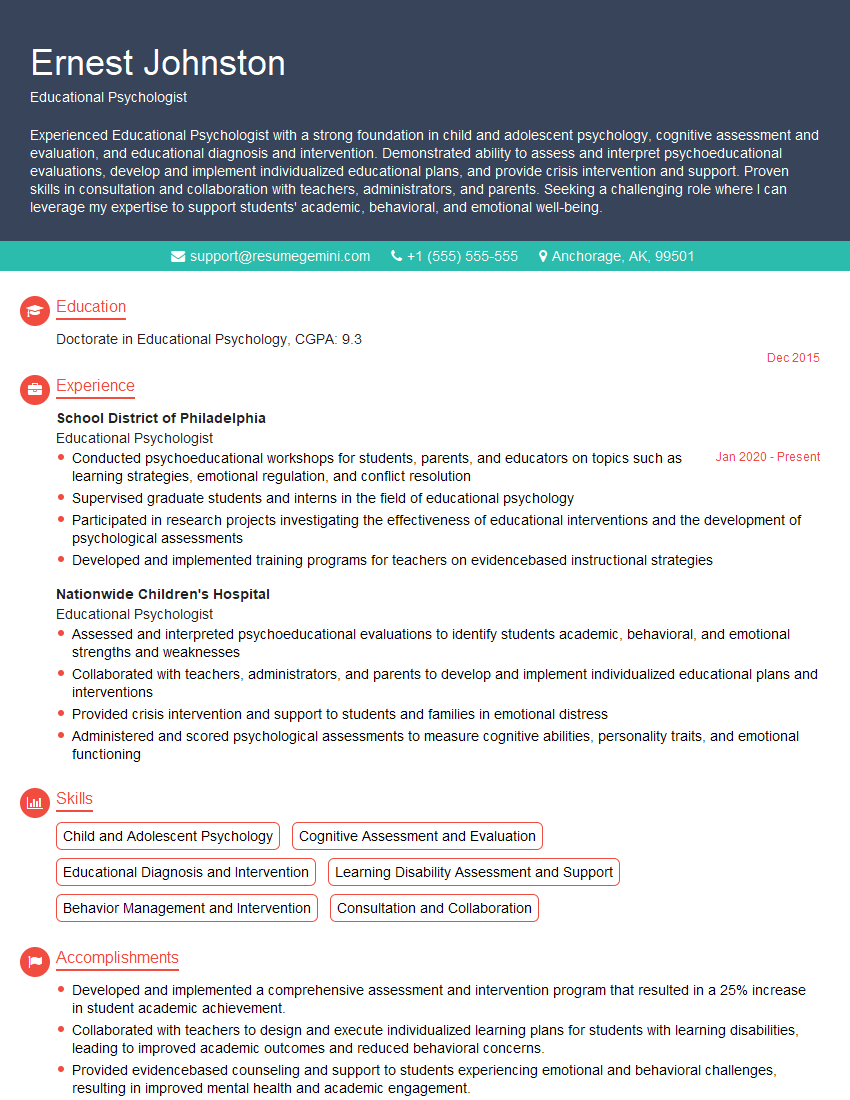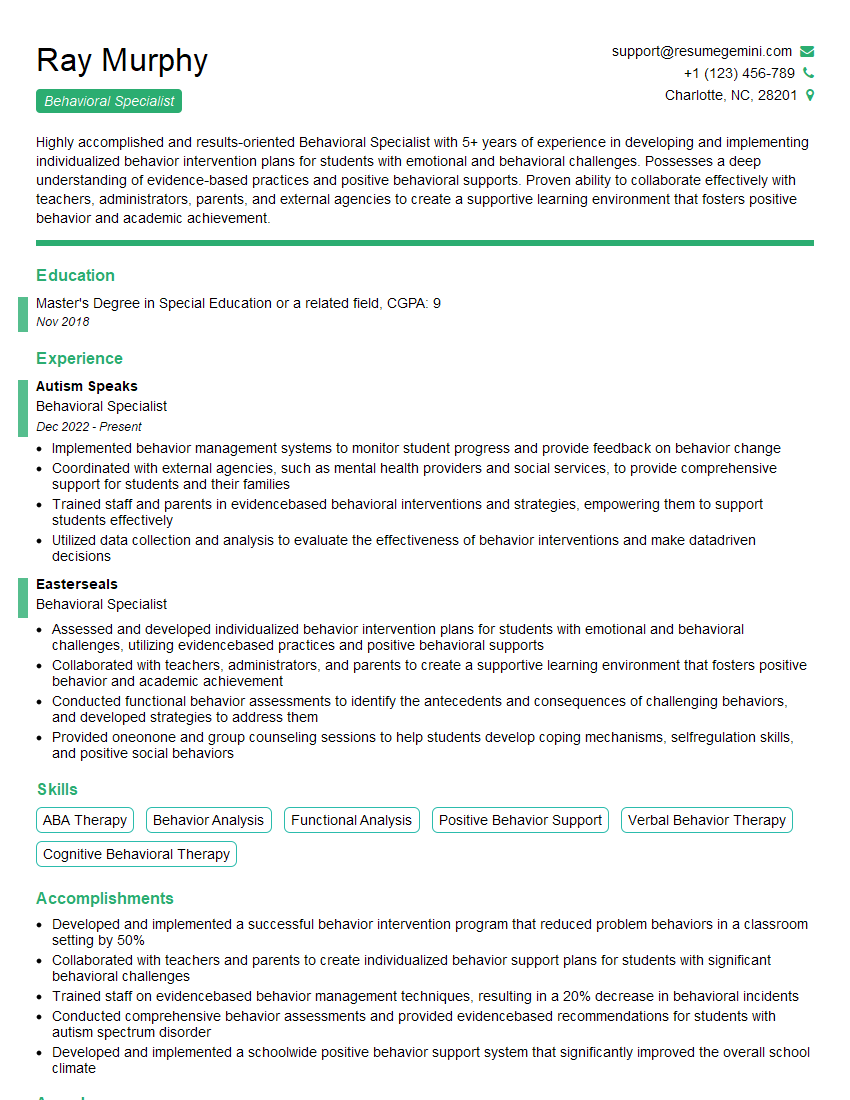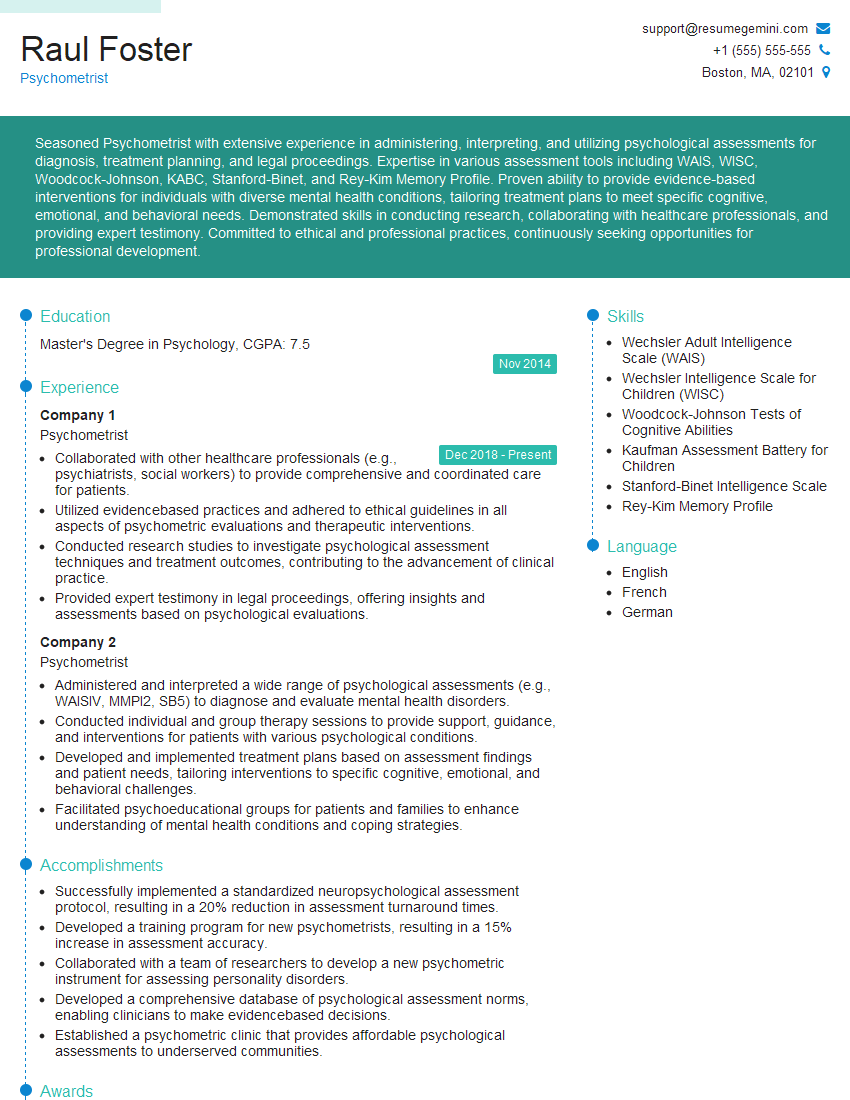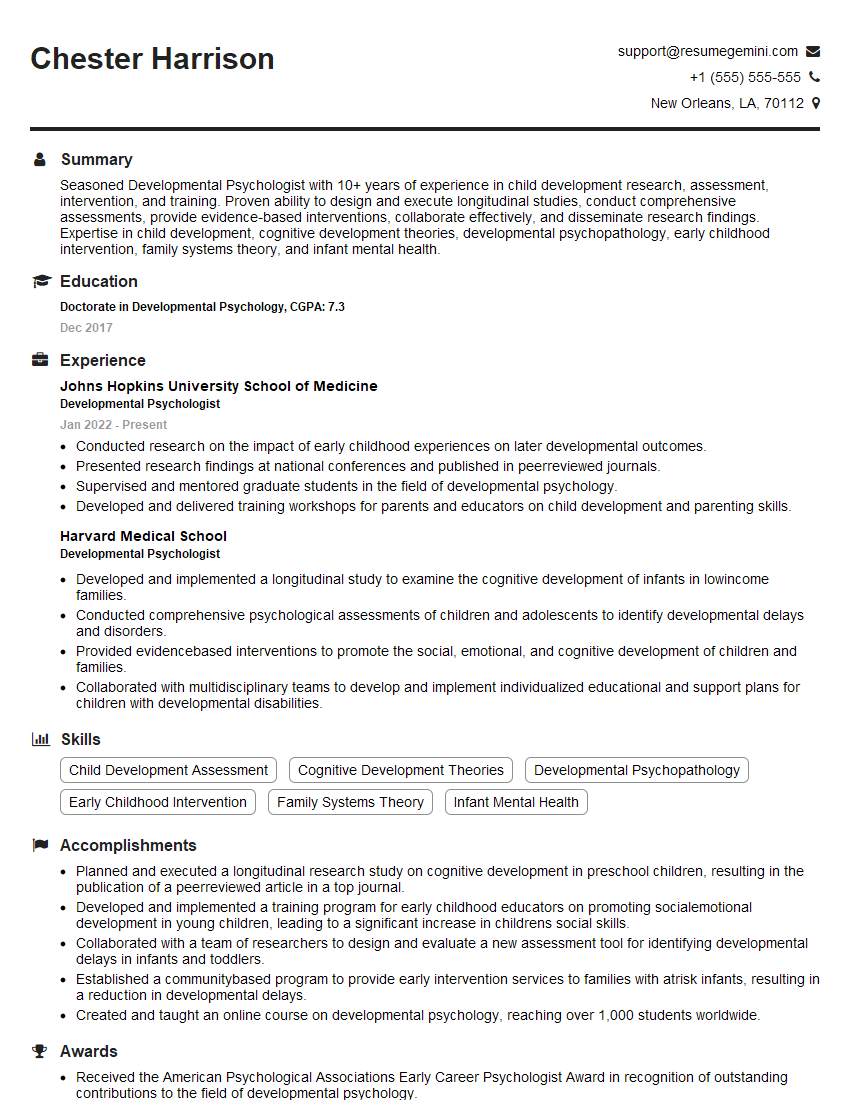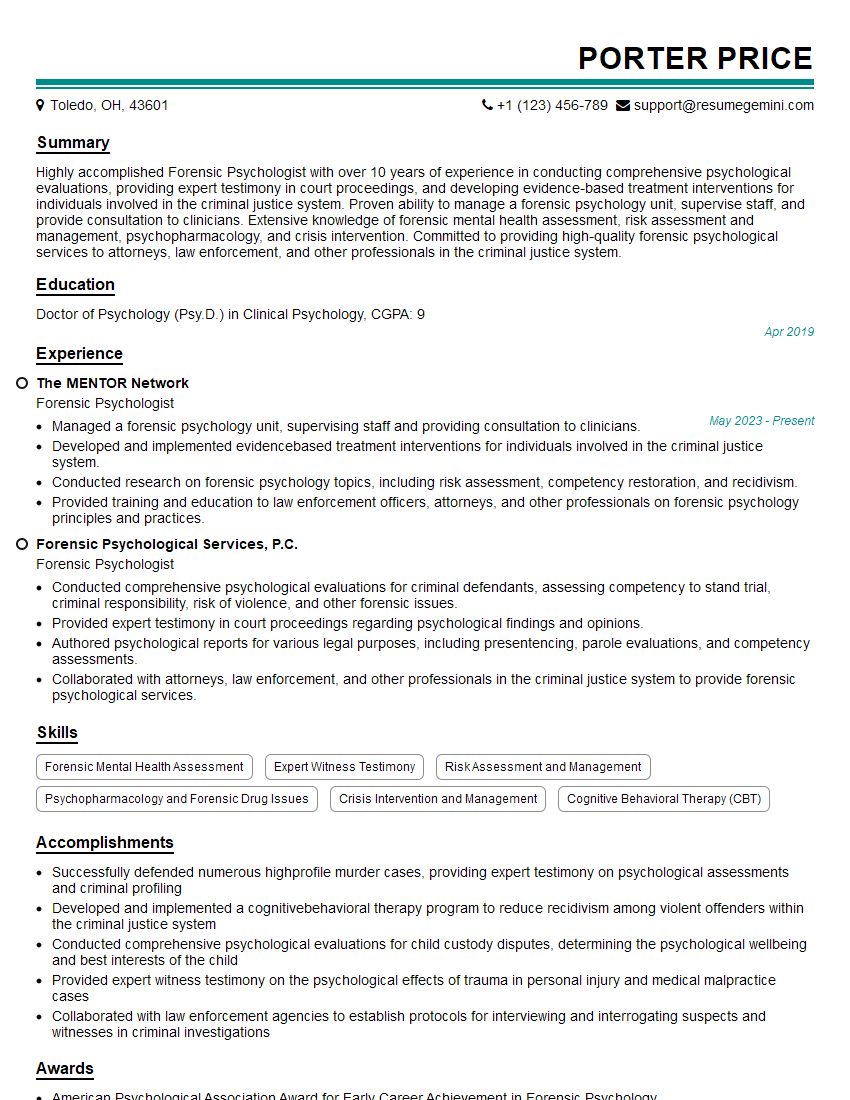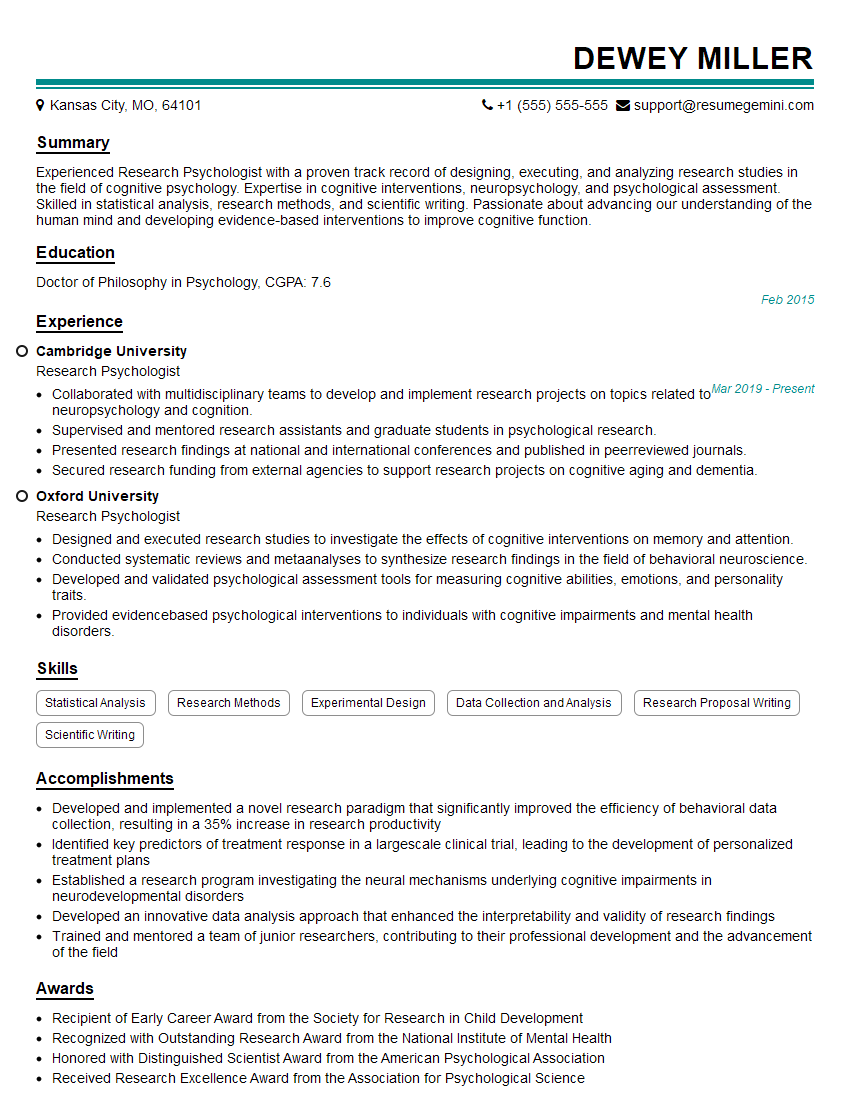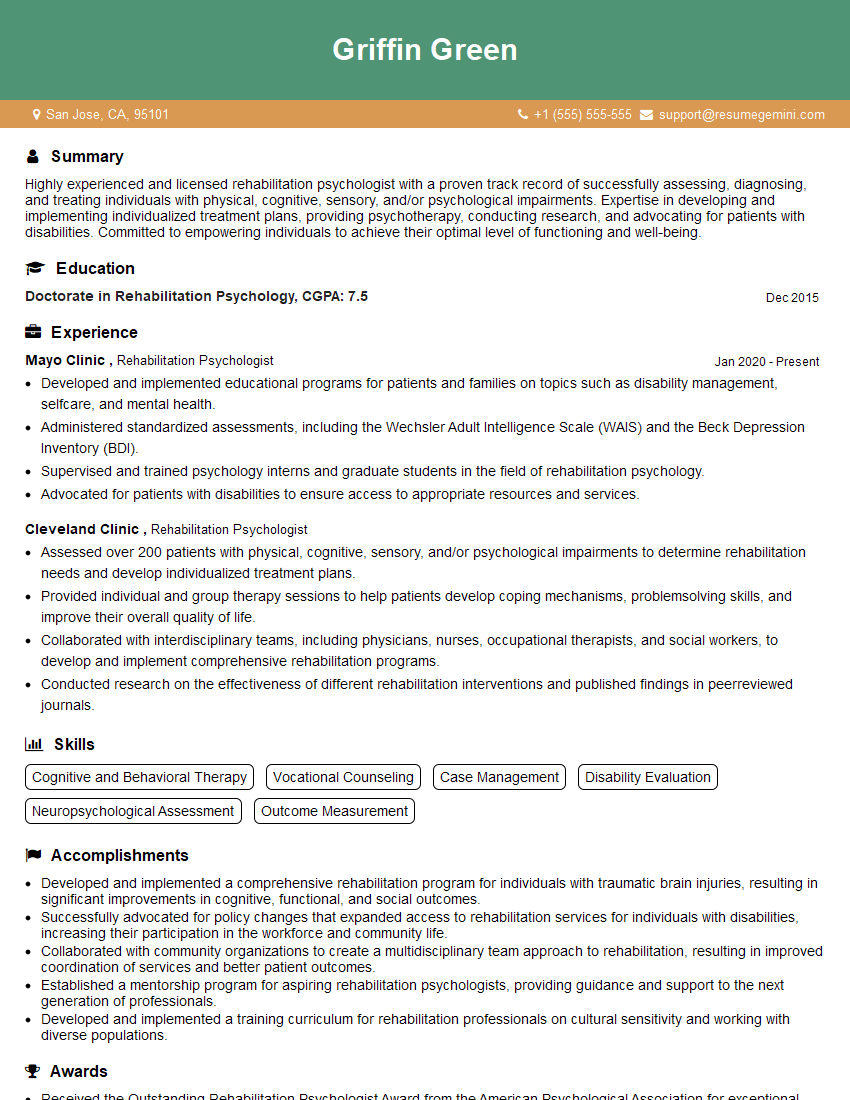The thought of an interview can be nerve-wracking, but the right preparation can make all the difference. Explore this comprehensive guide to Individual Intelligence Testing interview questions and gain the confidence you need to showcase your abilities and secure the role.
Questions Asked in Individual Intelligence Testing Interview
Q 1. Describe the Wechsler Adult Intelligence Scale (WAIS) and its subtests.
The Wechsler Adult Intelligence Scale (WAIS) is the most widely used intelligence test for adults, assessing cognitive abilities through a series of subtests. It provides a Full Scale IQ (FSIQ) score, along with scores for Verbal Comprehension, Perceptual Reasoning, Working Memory, and Processing Speed. These four indices offer a more nuanced understanding of an individual’s cognitive strengths and weaknesses than a single IQ score alone.
- Verbal Comprehension Index (VCI): Measures verbal reasoning, knowledge, and comprehension. Subtests include Similarities (finding relationships between concepts), Vocabulary (defining words), Information (general knowledge), and Comprehension (understanding social situations).
- Perceptual Reasoning Index (PRI): Assesses nonverbal reasoning, visual-spatial skills, and fluid intelligence. Subtests include Block Design (recreating patterns with blocks), Visual Puzzles (assembling fragmented images), Matrix Reasoning (completing patterns), and Picture Completion (identifying missing parts of pictures).
- Working Memory Index (WMI): Evaluates the ability to hold and manipulate information in mind. Subtests include Digit Span (repeating sequences of numbers), Arithmetic (solving math problems mentally), and Letter-Number Sequencing (ordering letters and numbers).
- Processing Speed Index (PSI): Measures the speed and efficiency of cognitive processing. Subtests include Symbol Search (finding matching symbols), Coding (copying symbols according to a key), and Cancellation (identifying specific targets among distractors).
For example, a client might score high on the VCI, indicating strong verbal abilities, but lower on the PSI, suggesting challenges with rapid information processing. This detailed profile is invaluable for developing targeted interventions or educational strategies.
Q 2. Explain the differences between the Stanford-Binet and Wechsler intelligence scales.
Both the Stanford-Binet and Wechsler scales are widely used intelligence tests, but they differ significantly in their approach and structure. The Stanford-Binet, historically a single-score test, now offers a composite IQ score and subtest scores, but traditionally focuses on a hierarchical model of intelligence, emphasizing a general intelligence factor (g). The Wechsler scales, conversely, employ a multi-faceted approach, generating multiple indices (as described above) that provide a more comprehensive profile of cognitive abilities, reducing reliance solely on a single ‘g’ factor.
Another key difference lies in their administration and age range. The Stanford-Binet can be administered to individuals across a wider age range, from early childhood to adulthood, while the Wechsler scales offer separate versions for different age groups (e.g., WAIS for adults, WISC for children). Finally, the item types and subtest content can also vary. While both assess verbal and nonverbal skills, the specific tasks and their difficulty levels can differ, impacting the overall assessment and interpretation.
Think of it like this: The Stanford-Binet might be like a comprehensive physical exam providing a general health overview, while the Wechsler scales are more like a series of specialized medical tests revealing specific strengths and weaknesses in different bodily systems.
Q 3. What are the key limitations of intelligence testing?
Intelligence testing, despite its usefulness, possesses several limitations. One significant limitation is that IQ scores don’t capture the full spectrum of human intelligence. They primarily assess specific cognitive abilities, neglecting other important aspects such as creativity, emotional intelligence, and practical skills. The tests are also culturally biased, meaning items might favor individuals from specific cultural backgrounds, leading to inaccurate or unfair assessments for those from diverse backgrounds.
Furthermore, test anxiety and situational factors can significantly influence performance. A nervous individual might underperform, leading to an inaccurate reflection of their true cognitive abilities. Finally, the interpretation of IQ scores can be complex and requires careful consideration of individual factors, as simply relying on a single number can be misleading. For example, a child with a specific learning disability might exhibit a lower overall IQ score but have exceptional talent in a particular area, such as art or music.
Q 4. How do you interpret IQ scores within the context of individual factors?
Interpreting IQ scores requires a holistic approach, moving beyond simply looking at the number. It’s crucial to consider individual factors like educational background, cultural influences, and any neurological or developmental conditions that could impact test performance. For instance, a low IQ score in a child who’s experienced significant educational disadvantage should not be interpreted in the same way as a similar score in a child with a diagnosed learning disability. Similarly, the same IQ score might reflect vastly different cognitive profiles depending on the individual’s strengths and weaknesses across the different subtest areas.
A comprehensive interpretation involves analyzing the individual’s pattern of subtest scores, considering qualitative observations made during the testing session, and integrating information from other sources, such as school records or clinical observations. Only through this holistic approach can a meaningful and accurate understanding of the individual’s cognitive abilities be achieved.
Q 5. Discuss the ethical considerations surrounding the administration and interpretation of intelligence tests.
Ethical considerations are paramount in intelligence testing. Confidentiality is critical, ensuring that test results are protected and only shared with authorized individuals. Test administrators have a responsibility to ensure the test is administered appropriately, following standardized procedures and avoiding any biases that might affect the outcome. Furthermore, the results should be interpreted accurately and sensitively, conveying the information in a way that is understandable and avoids causing undue distress or labeling the individual.
Informed consent is essential before administering any test. Individuals must understand the purpose of the assessment, what the results might reveal, and how this information will be used. It is also crucial to avoid the misuse of test results for discriminatory purposes, recognizing that intelligence testing is just one piece of the puzzle when assessing an individual’s overall capabilities and potential. The psychologist has a responsibility to ensure the integrity of the test and to minimize any potential risks to the participant.
Q 6. How do you ensure the test environment is optimal for accurate results?
Creating an optimal test environment is vital for accurate results. This involves minimizing distractions such as noise or interruptions, ensuring comfortable seating and lighting, and establishing a rapport with the individual to reduce test anxiety. The administrator should create a calm and supportive atmosphere that promotes the participant’s concentration and engagement in the task. This means being sensitive to their needs and making them feel comfortable and understood. A quiet, well-lit room, free from interruptions, is essential.
Additionally, the administrator must ensure that the instructions are clear and that the participant understands the tasks. This includes checking for comprehension and addressing any questions or concerns the individual might have. Any factors that could compromise the validity of the test results, such as language barriers or sensory impairments, should be carefully considered and addressed.
Q 7. What are the different types of intelligence test validity?
Intelligence test validity refers to how well the test measures what it claims to measure. There are several types of validity to consider:
- Content Validity: This assesses whether the test items adequately represent the entire domain of intelligence being measured. For example, a test claiming to assess general intelligence should cover various aspects like verbal reasoning, spatial skills, and working memory.
- Criterion Validity: This examines how well the test scores correlate with external criteria. For instance, does a high score on the test predict academic success or job performance? This can be further broken down into concurrent validity (correlation with current criteria) and predictive validity (correlation with future criteria).
- Construct Validity: This explores the extent to which the test measures the theoretical construct of intelligence. Does it accurately reflect the underlying cognitive processes and abilities that define intelligence? This involves examining both convergent validity (correlation with similar measures) and discriminant validity (lack of correlation with unrelated measures).
Ensuring high validity across these aspects is crucial for the accurate and meaningful interpretation of intelligence test scores.
Q 8. Explain the concept of reliability in intelligence testing and its importance.
Reliability in intelligence testing refers to the consistency of a test’s results. A reliable test will produce similar scores if administered to the same person multiple times under similar conditions. It’s crucial because without reliability, we can’t trust the scores to accurately reflect a person’s true intellectual abilities. Imagine a scale that gives different weights each time you weigh yourself – you wouldn’t trust it! Similarly, an unreliable IQ test would yield inconsistent scores, making any interpretations meaningless.
We assess reliability using several methods. Test-retest reliability measures the correlation between scores from the same test administered at different times. Internal consistency reliability examines how well the different items on a test measure the same construct. For example, if a test section measuring verbal reasoning has items that are not consistent with each other, it indicates low internal consistency. High reliability coefficients (typically above 0.80) indicate a reliable test. Low reliability can stem from factors like poor test design, ambiguous questions, or environmental influences during testing.
Q 9. How do you handle a client who becomes anxious or frustrated during testing?
Client anxiety or frustration during testing is a common occurrence, and handling it appropriately is vital for obtaining accurate and valid results. I always begin by creating a calming and supportive environment. This includes establishing rapport, explaining the testing process clearly and simply, and answering any questions the client may have. I might use reassuring language, offering breaks as needed, and adjusting my approach based on the individual’s needs.
If the anxiety is significant, I might adjust the pacing of the test, offering encouragement, or even rescheduling the session if necessary. In severe cases, collaboration with a psychologist or counselor might be advisable before proceeding with the testing. It’s important to remember that the goal is to assess cognitive abilities, not to induce further distress. A stressed client is unlikely to perform at their best.
Q 10. Describe your experience with administering different types of intelligence tests.
Throughout my career, I’ve administered a wide range of intelligence tests, catering to diverse age groups and needs. This includes the widely used Wechsler Adult Intelligence Scale (WAIS), the Wechsler Intelligence Scale for Children (WISC), and the Stanford-Binet Intelligence Scales. I’m experienced in administering both individually administered tests, which require close interaction with the client, and group-administered tests. My experience also extends to using culturally reduced tests where appropriate, recognizing the importance of minimizing cultural bias in assessment.
I’m proficient in administering both verbal and performance subtests, understanding the nuances of each and how they contribute to the overall IQ score. For example, the WAIS-IV includes subtests assessing verbal comprehension, perceptual reasoning, working memory, and processing speed. I’m comfortable interpreting the profiles generated from these tests and providing comprehensive reports based on the obtained data. Each test offers unique strengths and considerations for different assessment goals, and selecting the appropriate tool is crucial for accurate assessment.
Q 11. Explain the Flynn effect and its implications for interpreting IQ scores.
The Flynn effect describes the observation that IQ scores have been steadily rising across generations. This means that a person with an IQ of 100 today would have scored significantly higher a few decades ago. This trend isn’t due to people becoming inherently smarter, but rather to factors such as improved nutrition, better education, increased exposure to information, and more stimulating environments.
The implications for interpreting IQ scores are significant. We cannot directly compare IQ scores across different generations without considering the Flynn effect. Failing to account for it would lead to an inaccurate representation of intellectual capabilities over time. Therefore, current IQ tests are periodically renormed to account for the Flynn effect, ensuring that the average score remains at 100. This process maintains the validity and relevance of the IQ scores within their specific generational context.
Q 12. How do you identify and address cultural biases in intelligence testing?
Cultural bias in intelligence testing is a serious concern. Tests often inadvertently favor individuals from dominant cultural groups, leading to inaccurate assessments for those from different backgrounds. This bias can manifest in various ways: language used, content familiarity, and even testing format. For example, a question referencing a specific cultural event or symbol might be easily understood by some but completely unfamiliar to others.
To mitigate this, I use culturally fair or culturally reduced tests whenever possible. These tests aim to minimize reliance on specific cultural knowledge. I also pay careful attention to the client’s background and adapt my approach accordingly. This might involve using alternative assessment methods, such as nonverbal tests, or adjusting the language used. Furthermore, careful interpretation of results is crucial, considering potential cultural influences on performance and avoiding generalizations based solely on the test scores. It’s vital to remember that test scores provide only one piece of information about an individual’s abilities.
Q 13. What are some alternative assessment methods to standard IQ tests?
While standard IQ tests are valuable tools, alternative assessment methods offer complementary perspectives on cognitive abilities. These methods are particularly useful when standard tests aren’t appropriate due to cultural biases, language barriers, or individual limitations. Examples include:
- Adaptive testing: Adjusts the difficulty of questions based on the individual’s responses, providing a more precise assessment.
- Dynamic assessment: Focuses on the individual’s learning potential by observing how they respond to instruction and feedback.
- Portfolio assessment: Evaluates an individual’s abilities based on a collection of their work samples, projects, and achievements.
- Behavioral observations: Observe and record an individual’s behavior in different contexts to gather information about their cognitive skills and adaptive functioning.
These methods offer a more holistic view of an individual’s cognitive abilities and are useful in situations where traditional IQ tests might not capture the full picture. The choice of assessment method depends heavily on the individual’s needs and the specific goals of the assessment.
Q 14. Describe your experience with scoring and interpreting intelligence tests.
Scoring and interpreting intelligence tests require meticulous attention to detail and a deep understanding of psychometrics. The process begins with accurately recording the client’s responses, following the standardized procedures of the specific test being administered. Raw scores are then converted into scaled scores and standard scores using the test’s specific norms. This allows us to compare the individual’s performance to the performance of others in their age group.
Interpretation goes beyond simply assigning a single IQ number. I analyze the individual’s performance on different subtests to identify strengths and weaknesses. For example, a client might excel in verbal comprehension but struggle with visual-spatial reasoning. This profile provides a much richer understanding of the individual’s cognitive abilities than a single IQ score alone. Finally, I integrate this information with other relevant data, such as background information, behavioral observations, and other assessments, to develop a comprehensive report that considers the individual’s unique context.
Q 15. How do you explain complex test results to clients and their families?
Explaining complex intelligence test results requires sensitivity, clarity, and a client-centered approach. I begin by establishing a comfortable and non-judgmental environment, ensuring clients and families understand that the test is just one piece of the puzzle in understanding an individual’s abilities and needs. I avoid technical jargon and instead use plain language, focusing on the overall picture rather than getting bogged down in specific numbers. For example, instead of saying, “Your child scored in the 85th percentile on the verbal comprehension index,” I might say, “Your child demonstrates strong verbal reasoning skills, consistently performing above average in understanding and using language.” I then explain the implications of the results in a practical way, connecting them to the individual’s strengths and challenges in their everyday life – academic performance, social interactions, or daily living skills. I always emphasize the dynamic nature of intelligence, highlighting that scores are not fixed and can change with appropriate support and interventions. Finally, I provide a written summary of the results that avoids jargon and is easily understandable, including concrete recommendations for interventions or further assessments. I answer all their questions openly and honestly, and encourage them to ask for clarification on anything they don’t understand. I leave them with a sense of hope and empowerment, emphasizing that the results are intended to help them navigate challenges and reach their full potential.
Career Expert Tips:
- Ace those interviews! Prepare effectively by reviewing the Top 50 Most Common Interview Questions on ResumeGemini.
- Navigate your job search with confidence! Explore a wide range of Career Tips on ResumeGemini. Learn about common challenges and recommendations to overcome them.
- Craft the perfect resume! Master the Art of Resume Writing with ResumeGemini’s guide. Showcase your unique qualifications and achievements effectively.
- Don’t miss out on holiday savings! Build your dream resume with ResumeGemini’s ATS optimized templates.
Q 16. Describe your experience working with individuals with intellectual disabilities.
My experience working with individuals with intellectual disabilities has been deeply rewarding and has provided invaluable insights into the complexities of human intelligence. I’ve worked with individuals across a wide range of functioning levels, utilizing adaptive assessments tailored to their specific needs and communication abilities. For example, I’ve used nonverbal tests like the Leiter-R and the nonverbal portions of the WISC-V to assess cognitive abilities in individuals with limited verbal skills. I’ve also collaborated with multidisciplinary teams—including educators, therapists, and social workers—to develop individualized education programs (IEPs) and support plans. A particularly memorable case involved a young adult with Down syndrome who, through consistent support and specialized instruction, made significant progress in his adaptive skills and life independence. In this instance, the testing was crucial in understanding his strengths and challenges, enabling us to tailor the intervention to optimize his progress. Beyond the testing, a key element is fostering a supportive and encouraging environment, celebrating small victories, and focusing on strengths to promote self-esteem and autonomy. The goal is always to empower individuals to live full and meaningful lives.
Q 17. What are the key indicators of giftedness identified through intelligence testing?
Identifying giftedness through intelligence testing goes beyond simply achieving a high overall IQ score. While a high IQ (typically above 130) is often a component, several key indicators emerge. These include: exceptional performance on specific cognitive abilities, such as verbal comprehension, perceptual reasoning, working memory, and processing speed; rapid learning and information retention; advanced problem-solving skills, including divergent thinking (generating multiple solutions); creativity and originality; intense curiosity and a thirst for knowledge; and advanced vocabulary and language comprehension. Furthermore, giftedness often manifests in a profound passion or talent in a specific area, such as music, art, science, or mathematics. It’s crucial to note that giftedness is multi-faceted and involves a complex interplay of cognitive abilities, creativity, motivation, and personality traits. Intelligence tests offer a valuable glimpse into cognitive potential but should always be considered within a broader assessment that includes observations, teacher reports, and parent input to develop a comprehensive understanding.
Q 18. How do you utilize intelligence test results to inform educational or therapeutic interventions?
Intelligence test results are not just numbers; they are valuable tools informing tailored educational and therapeutic interventions. The results illuminate an individual’s cognitive strengths and weaknesses, guiding the selection of appropriate learning strategies and interventions. For example, a child struggling with working memory might benefit from strategies like breaking down tasks into smaller steps, using visual aids, and employing mnemonic devices. Similarly, a child with superior verbal comprehension skills could be challenged with more complex reading material and advanced vocabulary exercises. In a therapeutic setting, the results can inform the selection of appropriate treatment modalities and goal setting. A client’s strengths and weaknesses in cognitive processing can influence the type of therapy, the frequency of sessions, and the targeted goals of therapy. It’s imperative to remember that test results are just one aspect of a comprehensive assessment. They should be considered in conjunction with other information, such as academic records, behavioural observations, and clinical interviews, to create an individualized plan. The goal is to leverage the individual’s strengths and support their areas of weakness to achieve their full potential.
Q 19. Explain the role of nonverbal assessments in evaluating intelligence.
Nonverbal assessments play a crucial role in evaluating intelligence, particularly when assessing individuals with language impairments, learning disabilities, or cultural backgrounds different from the test’s norming population. These assessments minimize the reliance on verbal skills, focusing instead on visual-spatial reasoning, problem-solving abilities, and other nonverbal cognitive functions. Examples include the Leiter International Performance Scale-Revised and the nonverbal reasoning sections of tests like the WISC-V or Stanford-Binet. These tests are particularly valuable in identifying cognitive strengths and weaknesses that might be masked by language barriers. For instance, a child with a language processing disorder might have difficulty expressing their understanding verbally but show excellent nonverbal reasoning skills on a test like the Leiter. Incorporating nonverbal assessments enhances the validity and reliability of the overall evaluation, providing a more holistic understanding of the individual’s cognitive abilities.
Q 20. Describe your familiarity with various scoring systems and software used in intelligence testing.
My familiarity with various scoring systems and software used in intelligence testing is extensive. I’m proficient in administering and interpreting numerous tests, including the Wechsler Intelligence Scales for Children (WISC-V), the Wechsler Adult Intelligence Scale (WAIS-IV), the Stanford-Binet Intelligence Scales, and various nonverbal assessments. I’m experienced using the accompanying software for these tests, including the automated scoring and report generation features. These programs provide comprehensive analyses of test results, including subtest scores, scaled scores, percentile ranks, and confidence intervals. Furthermore, I understand the different scoring systems used in various tests, including standard scores, deviation IQs, and age equivalents. This knowledge allows me to accurately interpret the results and translate them into meaningful information for clients and their families. My familiarity extends to using these data to generate reports that are both statistically sound and readily understandable by non-specialists. Keeping up to date with new developments in testing technology and scoring systems is an ongoing process to ensure I maintain the highest levels of competence.
Q 21. How do you maintain confidentiality and security of test data?
Maintaining confidentiality and security of test data is paramount. I adhere to strict ethical guidelines and legal regulations regarding the privacy of client information. All test materials are stored securely in locked cabinets, and electronic data are password-protected and encrypted using industry-standard security protocols. I follow stringent procedures for the disposal of test materials, ensuring that client data is never compromised. Furthermore, I obtain informed consent from clients before administering any assessments, fully explaining the purpose of testing, how the data will be used, and who will have access to it. I limit the release of information only to authorized individuals involved in the client’s care, such as therapists, educators, or other healthcare professionals. In all communications, I maintain strict confidentiality, never disclosing identifying information or discussing test results in public spaces. I am fully aware of HIPAA regulations and other relevant laws concerning the protection of health information and strictly adhere to all those guidelines in my professional practice.
Q 22. Describe a time you had to adapt a testing procedure due to a client’s needs.
Adapting testing procedures is crucial for ensuring fair and accurate assessments. I once worked with a client who was visually impaired. While the standard Wechsler Adult Intelligence Scale (WAIS) is primarily administered visually, adapting the procedure was essential for this client.
My approach involved several steps. First, I consulted the test manual for guidelines on adapting the test for visually impaired individuals. Many tests offer alternative formats or accommodations. This specific manual suggested tactile materials and verbal administration for certain subtests. Second, I collaborated closely with the client to ensure comfort and understanding throughout the process. This included explaining each subtest clearly and patiently, ensuring they understood the instructions before beginning. Third, I made detailed notes documenting all the adaptations made and any observations about the client’s performance, including the accommodations provided. This ensured the results accurately reflected their cognitive abilities, not their visual impairment. This experience highlighted the importance of flexibility and individualized assessment in intelligence testing.
Q 23. What are the potential legal implications of misinterpreting intelligence test results?
Misinterpreting intelligence test results can have serious legal implications, particularly in educational and employment settings. Incorrect interpretations can lead to inappropriate educational placements, unfair hiring decisions, and even denial of services based on inaccurate assessments.
For example, incorrectly diagnosing a child as intellectually disabled based on flawed test administration or interpretation could lead to their placement in a restrictive educational setting, limiting their opportunities for growth and potentially violating their rights to appropriate education under laws like the Individuals with Disabilities Education Act (IDEA). Similarly, misinterpreting results in an employment context could lead to discrimination lawsuits if hiring decisions are based on inaccurate assessments of a candidate’s cognitive abilities. Therefore, rigorous adherence to testing protocols and ethical considerations is paramount in avoiding legal repercussions.
Furthermore, psychologists have a legal and ethical responsibility to ensure accurate test administration, scoring, and interpretation, as outlined by codes of ethics from organizations like the American Psychological Association (APA). Failure to do so can result in professional sanctions, including license suspension or revocation.
Q 24. How do you differentiate between intelligence and achievement?
Intelligence and achievement are related but distinct concepts. Intelligence refers to an individual’s potential cognitive ability – their capacity for learning and problem-solving. Achievement, on the other hand, reflects what an individual has actually learned or accomplished. Think of it like this: intelligence is the engine, while achievement is the distance traveled.
A person with high intelligence might have the potential to achieve a great deal, but without sufficient opportunity, motivation, or instruction, their actual achievement might be lower. Conversely, someone with average intelligence but strong work ethic and access to good education could achieve a high level of accomplishment. Intelligence tests, such as the Stanford-Binet or WAIS, attempt to measure potential, while achievement tests, such as standardized academic tests, assess what has been learned. A comprehensive evaluation often includes both types of assessments to gain a complete understanding of an individual’s abilities and performance.
Q 25. Discuss the impact of different learning styles on intelligence test performance.
Learning styles, such as visual, auditory, or kinesthetic preferences, can significantly impact performance on intelligence tests. Most standard intelligence tests are heavily reliant on visual-spatial skills and verbal comprehension. This creates a potential bias favoring individuals with these dominant learning styles. For example, a student who is a strong kinesthetic learner might struggle with tasks requiring prolonged sitting and focused visual attention, leading to a lower score than their actual cognitive ability might suggest.
To address this, careful consideration of a test-taker’s learning style is crucial. While adapting standard tests can be challenging, providing accommodations, like using verbal instructions for a visual task if appropriate or giving frequent breaks for kinesthetic learners, can help mitigate the impact of learning styles on test performance. Observing the client’s preferred learning style during the assessment and documenting these observations in the report is vital to provide a comprehensive and accurate assessment that goes beyond just a score.
Q 26. How do you identify and manage test-taker bias during administration?
Test-taker bias can significantly influence the results of an intelligence test. This bias can stem from factors like anxiety, cultural differences in test familiarity, or even the test administrator’s behavior. Identifying and managing this bias is critical to ensuring a fair and accurate assessment.
My approach involves several strategies: establishing rapport to reduce anxiety, ensuring the client understands the instructions clearly in their native language (if necessary), using culturally appropriate stimuli where possible, and maintaining a neutral and unbiased demeanor during the test administration. Furthermore, I strive to create a comfortable and supportive testing environment. This helps reduce anxiety which can disproportionately impact certain test-takers. Careful observation of the client’s behavior during the test also allows me to detect signs of anxiety or confusion, which can be addressed by clarifying instructions or providing reassurance.
Finally, choosing standardized tests that have been rigorously evaluated for cultural fairness and considering alternative assessment methods in situations where standard tests might be inappropriate are crucial for minimizing test-taker bias.
Q 27. What ongoing professional development activities do you engage in to maintain your competence in this area?
Maintaining competence in individual intelligence testing requires ongoing professional development. This involves a multi-pronged approach.
- Continuing Education Courses: I regularly participate in workshops and seminars focused on the latest advancements in psychometrics, intelligence testing methodologies, and ethical considerations in assessment.
- Conferences and Workshops: Attending professional conferences allows me to network with colleagues and learn about new research and best practices in the field.
- Professional Journals and Publications: I subscribe to relevant journals like the Journal of Consulting and Clinical Psychology and regularly review new publications on intelligence testing and related fields.
- Supervision and Peer Consultation: I actively seek supervision from experienced colleagues, discussing challenging cases and refining my assessment techniques.
This continuous learning ensures I stay abreast of new developments, refine my skills, and maintain the highest standards of ethical and professional practice.
Q 28. How do you stay updated with the latest research and advancements in individual intelligence testing?
Staying updated in the dynamic field of individual intelligence testing requires a proactive approach.
- Professional Organizations: Membership in organizations like the American Psychological Association (APA) provides access to resources, publications, and conferences dedicated to psychological assessment.
- Databases and Online Resources: I utilize online databases like PsycINFO and PubMed to search for relevant research articles and publications.
- Test Publishers’ Websites: Regularly checking the websites of major test publishers (e.g., Pearson, Harcourt Assessment) provides information on test updates, new releases, and relevant research.
- Networking and Collaboration: Engaging with colleagues in the field through professional networks and attending conferences allows for the exchange of knowledge and insights on the latest research and developments.
This multifaceted strategy ensures that my knowledge base remains current, allowing me to provide the most accurate and effective assessments for my clients.
Key Topics to Learn for Individual Intelligence Testing Interview
- Theoretical Foundations: Understand the history and evolution of intelligence testing, different theoretical models (e.g., Spearman’s g factor, Cattell-Horn-Carroll theory), and their implications for test design and interpretation.
- Test Administration and Scoring: Master the procedures for administering various individual intelligence tests (e.g., Wechsler scales, Stanford-Binet), accurate scoring techniques, and the importance of standardized procedures.
- Interpreting Test Results: Develop proficiency in analyzing individual test profiles, identifying strengths and weaknesses, and writing comprehensive reports that are both technically sound and easily understood by non-professionals.
- Ethical Considerations: Familiarize yourself with ethical guidelines related to intelligence testing, including cultural fairness, test bias, informed consent, and confidentiality.
- Practical Applications: Explore the diverse applications of individual intelligence testing across various settings, such as educational psychology, clinical psychology, neuropsychology, and talent assessment.
- Differential Diagnosis: Learn to differentiate between various cognitive disorders and intellectual disabilities based on intelligence test findings, integrating other assessment data for a comprehensive evaluation.
- Psychometric Properties: Understand key psychometric concepts like reliability, validity, standardization, and norming, and their application to the interpretation and evaluation of intelligence test results.
- Working with Diverse Populations: Develop sensitivity and awareness in working with individuals from diverse cultural, linguistic, and socioeconomic backgrounds, addressing potential biases in testing and interpretation.
Next Steps
Mastering individual intelligence testing opens doors to rewarding careers in various fields, offering opportunities for significant impact and professional growth. A strong resume is crucial for showcasing your expertise to potential employers. Creating an ATS-friendly resume that highlights your skills and experience in individual intelligence testing is paramount to securing your dream job. We highly recommend utilizing ResumeGemini to build a professional and impactful resume. ResumeGemini provides tools and resources to help you craft a compelling narrative, and we offer examples of resumes tailored specifically to the field of Individual Intelligence Testing to help you get started.
Explore more articles
Users Rating of Our Blogs
Share Your Experience
We value your feedback! Please rate our content and share your thoughts (optional).
What Readers Say About Our Blog
This was kind of a unique content I found around the specialized skills. Very helpful questions and good detailed answers.
Very Helpful blog, thank you Interviewgemini team.
